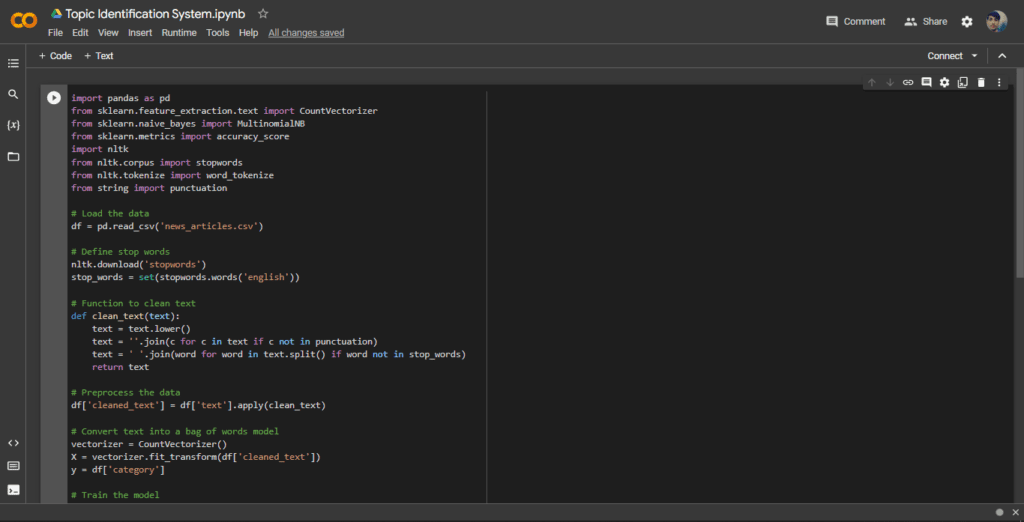Topic Identification System in Python
In this article we discuss how to create Topic Identification System in Python This system can be used classify text into different categories or topics. This is popular application of machine learning in natural language processing (NLP).
Concept Identification System in Python
How to Build a Keyword Identification System in Python
Python Program for Lungs Cancer Detection using Random Forest
Step 1: Import Libraries
We will start by importing necessary libraries. We will be using pandas library for data handling scikit learn library for machine learning and nltk library for natural language processing.
import pandas as pd
from sklearn.feature_extraction.text import CountVectorizer
from sklearn.naive_bayes import MultinomialNB
from sklearn.metrics import accuracy_score
import nltk
from nltk.corpus import stopwords
from nltk.tokenize import word_tokenize
Step 2: Load Data
Next we will load data that we will be using train our topic identification system. In example we will be using a dataset of news articles from different categories. We will use pandas library to load dataset.
df = pd.read_csv('news_articles.csv')
Step 3: Data Preprocessing
Before we can use data to train our topic identification system we need to preprocess data. This involves cleaning data and converting it into a format that can be used by machine learning algorithms.
First we will remove any punctuation from text and convert all text to lowercase. We will also remove any stop words from the text which are common words that do not add much meaning to the text.
nltk.download('stopwords')
stop_words = set(stopwords.words('english'))
def clean_text(text):
text = text.lower()
text = ''.join(c for c in text if c not in punctuation)
text = ' '.join(word for word in text.split() if word not in stop_words)
return text
df['cleaned_text'] = df['text'].apply(clean_text)
Next we use Count Vectorizer from scikit learn to convert text into bag of words model. This converts text into matrix of word counts where each row represents document and each column represents a word.
vectorizer = CountVectorizer()
X = vectorizer.fit_transform(df['cleaned_text'])
Step 4: Train Model
Now that we have preprocessed data we can use it to train our topic identification model. In this example we will be using Multinomial Naive Bayes algorithm which popular algorithm for text classification.
y = df['category']
model = MultinomialNB()
model.fit(X, y)
Step 5: Test Model
Finally we will test model on some new data to see how well it performs. We will load a test dataset and preprocess it in same way as we did with training data. We will then use trained model to predict categories of test data.
test_df = pd.read_csv('test_articles.csv')
test_df['cleaned_text'] = test_df['text'].apply(clean_text)
X_test = vectorizer.transform(test_df['cleaned_text'])
y_test = test_df['category']
y_pred = model.predict(X_test)
accuracy = accuracy_score(y_test, y_pred)
print('Accuracy: ', accuracy)
The output will be the accuracy of the model on the test data.

Complete Code Implementation using Colab
Here is complete code implementation for Topic Identification System in Python using Colab:
import pandas as pd
from sklearn.feature_extraction.text import CountVectorizer
from sklearn.naive_bayes import MultinomialNB
from sklearn.metrics import accuracy_score
import nltk
from nltk.corpus import stopwords
from nltk.tokenize import word_tokenize
from string import punctuation
# Load the data
df = pd.read_csv('news_articles.csv')
# Define stop words
nltk.download('stopwords')
stop_words = set(stopwords.words('english'))
# Function to clean text
def clean_text(text):
text = text.lower()
text = ''.join(c for c in text if c not in punctuation)
text = ' '.join(word for word in text.split() if word not in stop_words)
return text
# Preprocess the data
df['cleaned_text'] = df['text'].apply(clean_text)
# Convert text into a bag of words model
vectorizer = CountVectorizer()
X = vectorizer.fit_transform(df['cleaned_text'])
y = df['category']
# Train the model
model = MultinomialNB()
model.fit(X, y)
# Test the model
test_df = pd.read_csv('test_articles.csv')
test_df['cleaned_text'] = test_df['text'].apply(clean_text)
X_test = vectorizer.transform(test_df['cleaned_text'])
y_test = test_df['category']
y_pred = model.predict(X_test)
accuracy = accuracy_score(y_test, y_pred)
print('Accuracy: ', accuracy)
Here are some useful links for text classification datasets that you can use to train and test topic identification system using Python:
- 20 Newsgroups: http://qwone.com/~jason/20Newsgroups/
- Reuters-21578: https://archive.ics.uci.edu/ml/datasets/reuters-21578+text+categorization+collection
- IMDB Movie Reviews: https://ai.stanford.edu/~amaas/data/sentiment/
- AG News: https://www.di.unipi.it/~gulli/AG_corpus_of_news_articles.html
- BBC News Classification: http://mlg.ucd.ie/datasets/bbc.html
- Yelp Reviews: https://www.yelp.com/dataset/challenge
- Amazon Reviews: https://s3.amazonaws.com/amazon-reviews-pds/readme.html
These datasets contain text data and corresponding categories that you can use to train and test the topic identification system code provided earlier in this article. Additionally, you can also search for other datasets on Google or Kaggle that may be more suitable for your specific use case.